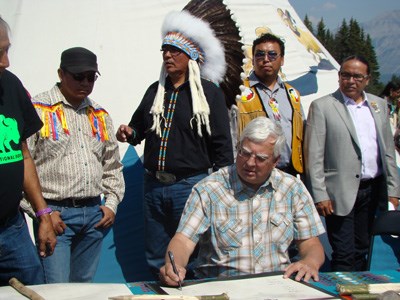Last updated: April 5, 2018
Article
Bison Bellows: Wildlife Conservation Society and American Bison Society

Photo courtesy of Harvey Locke.
"We stand for wildlife"---a motto prominent on the Wildlife Conservation Society's (WCS's) website. Established originally as the New York Zoological Society (NYZS) in 1895, WCS has over a century of dedicated experience protecting wildlife and habitats around the world. Bison are one of the flagship species that has been a part of WCS's conservation portfolio for more than 100 years.
In 1905, when fewer than 1,000 bison remained in North America, the NYZS founded the American Bison Society (ABS) to help save bison from extinction. The NYZS's Bronx Zoo sheltered bison to recover their numbers and then transported these bison back to their historical range in the west in order to repopulate bison herds that are still seen today. One hundred years later in 2005, WCS re-established ABS with the goal of advancing efforts for ecological restoration of bison. Today, ABS and WCS bring people, science, and culture together to reestablish wild bison as a keystone herbivore in large, intact grassland landscapes within their historic range across North America.
WCS and ABS collaborate with a variety of stakeholders, integrating ecology, economics, and restoration principles into community outreach, education, and on-the-ground initiatives for the conservation of bison. For example, in 2014, Keith Aune, Director of WCS's Bison Conservation Program, helped facilitate the signing of the Buffalo Treaty by 13 indigenous nations as the first cross-border indigenous treaty creating an intertribal alliance between the United States and Canada. This treaty helped to restore bison to 6.3 million acres of Tribal and First Nations lands. WCS is also currently working with the United States, Canada, and the Blackfeet Nation to transfer bison from Elk Island National Park in Alberta to their bison ancestors' ranges on the Blackfoot Reservation in Montana. In the public sector of bison conservation and management, WCS is collaborating with federal agencies to collect demographic and genetic data from 19 bison herds managed by the U.S. federal government. These data will be used in population viability analyses that will provide valuable science-based information to guide management strategies that can contribute to the long-term recovery of the species across the continent.
Beyond on-the-ground collaborative stewardship efforts, WCS's "Vote Bison" campaign focuses on two tasks: establish National Bison Day and elect bison as our Nation's mammal. The U.S. Senate has unanimously supported the National Bison Day campaign since 2012, with the first Saturday in November designated as the annual celebration of the American bison. Every year to commemorate National Bison Day, WCS encourages you to "put on a beard and celebrate the bison" by sharing a photo of your best beard for the "#BeardsforBison" social media outreach . The Vote Bison campaign is ultimately striving for Congress to cosponsor the National Bison Legacy Act. This bill would make bison the national mammal of the United States. As of March 24, 2016, there is news that House of Representative lawmakers could be voting on this bill soon, and upon the Senate revisiting their unanimous vote should there be any amendments in the House bill, we may see our nation electing bison as our national mammal!
